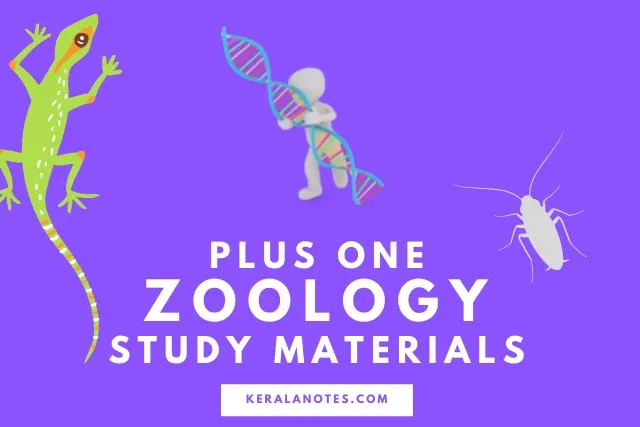An article about study materials for zoology can be found at Kerala Syllabus Plus One Zoology Pdf Study Materials. Are you looking for Kerala Board Class 11 Zoology study materials? The study resources for Zoology for Kerala Syllabus Plus One students have been compiled by us.
Trying to find KERALA SYLLABUS and one Zoology Study Guide. As a result, our Study Material is ideal for helping you prepare for the Plus One exam. The top zoology study guides for Kerala Syllabus Plus One should be used. Along with example papers for zoology, we have compiled a list of the Best Zoology books, notes, and study guides. If you're a zoologist, you may work in pharmaceutical labs, animal behaviour programmes, or overseas improving the standard of living in underdeveloped countries through environmental efforts.
These study resources cover every chapter of Class XI Zoology in depth and include assignments, examples, objective questions, fully solved problems, and deep theory.
| Board | SCERT, Kerala |
| Text Book | NCERT Based |
| Class | Plus One |
| Subject | Zoology |
| Materials Provided | Notes, Textbook Solutions, Solved Question Paper |
| Category | Plus One Kerala |
Kerala Higher Secondary Plus One Zoology Chapter Wise Study Materials
- Chapter 1 : The Living World
- Chapter 2 : Animal Kingdom
- Chapter 3 : Structural Organisation in Animals
- Chapter 4 : Biomolecules
- Chapter 5 : Digestion and Absorption
- Chapter 6 : Breathing and Exchange of Gases
- Chapter 7 : Body Fluids and Circulation
- Chapter 8 : Excretory Products and their Elimination
- Chapter 9 : Locomotion and Movement
- Chapter 10 : Neural Control and Coordination
- Chapter 11 : Chemical Coordination and integration
Plus One Zoology Part I
Plus One Zoology Part II
- Chapter 1 : The Living World
- Chapter 2 : Animal Kingdom
- Chapter 3 : Structural Organisation in Animals
- Chapter 4 : Biomolecules
- Chapter 5 : Digestion and Absorption
- Chapter 6 : Breathing and Exchange of Gases
- Chapter 7 : Body Fluids and Circulation
- Chapter 8 : Excretory Products and their Elimination
- Chapter 9 : Locomotion and Movement
- Chapter 10 : Neural Control and Coordination
- Chapter 11 : Chemical Coordination and integration
Plus One Zoology Part I
Plus One Zoology Part II
Plus one Biology Chap. 1 The Animated World
Students learn about the many species of flora and wildlife in nature in this chapter. It asks, "What is left?" The taxonomy then discusses categories and offers assistance. The most significant subject, that of species and species categorization, will be introduced to the students. They enter the lovely realm of living creatures and learn facts about their environment and behaviour that were previously unknown. They received education on biodiversity and the need of protecting both. All young people today should uphold these values, and this chapter works to instil such values in them.
Animal Kingdom, Plus One, Chapter 2 of Biology
This chapter discusses Kingdom Animalia, which is the most significant kingdom. Despite the variations in size and structure, there are a few distinguishing characteristics that make it simple to categorise them. Porifera, Coelenterata (Cnidaria), Ctenophora, Platyhelminthes, Eschelaminthes, Annelida, Arthropoda, Mollusca, Echinodermata, Hemichordata, and Chordata were all categorised for us. Additionally, the long-term future lies in the survival strategies, physiology, environment, and anatomy of animals. The last section of this chapter is Section 1, Diversity of Organisms. It received 7 points on the final test and 14% on the need exam
Plus One Biology Animal Structural Structure, Chapter 3
Numerous single-celled and multicellular creatures have previously been covered in class. Multicellular organisms, as opposed to unicellular ones, repair cells and carry out these tasks sequentially.
The learner studies in-depth information on the morphology and anatomy of frogs, cockroaches, and earthworms. It earned 5 points on the NEET test and 12 points on the final exam to successfully pass Section 2, Structural Association in Plants and Animals.
Plus one Biology Section 4 Bio-Molecules
Students learn about biological molecules in this lesson, as well as their purposes, structures, and significance. They will study biological molecules including proteins, enzymes, and metabolites. They are aware of how crucial enzymes are in biological processes.
Plus One Biology Digestion and Absorption in Chapter 5
Students start to study about human physiology in this section and get an understanding of how their own bodies function.
The primary topics of this chapter are digestion and food digestion. Additionally, a brief discussion on digestive tract diseases is included. The chapter discusses several food kinds that are crucial to our everyday diets and describes the issues brought on by their deficiencies.
Plus One Biology Chapter 6: Gas Exchange and Breathing
The notion of respiration is introduced to the learner in this chapter, along with its differences from respiration.
The respiratory system and the organs that make up both of the organs are highlighted. There is a thorough discussion of the exchange and transportation of gases like oxygen and carbon dioxide. Additionally, the causes of treatment issues are briefly explained to the students.
Plus One Biology Body Fluids and Circulation Chapter 7
Humans and other more sophisticated species have evolved to the circulatory system. This subject is pertinent to this subject.
The inadequacies of the mass movement will be shown to the students. He gained knowledge of the blood, its constituent parts, lymph (tissue fluid), blood types, etc. He gained knowledge of the electrocardiograph and cardiac problems.
Plus One Biology Excretory Products and Their Elimination in Chapter 8
It is only reasonable to be interested in the elimination of solid and liquid wastes originating from metabolic processes or excessive intake since the students only discussed waste gases in the previous chapter. Consequently, the human excretory system is the subject of this chapter. The auxiliary organs were among the components of the exhaust system that the students studied about. Additionally, they studied how urine is produced and how to manage kidney function. He was found to have many renal conditions.
Plus One Biology chapter nine Movement and Locomotion
The many forms of motions and movements in both unicellular and multicellular organisms are covered in this chapter for the benefit of the students. There has long been discussion of the skeletal and muscular systems. The different spontaneous and non-spontaneous muscular motions, muscle anatomy, and related diseases including gout, osteoporosis, and arthritis are all covered in this chapter.
Plus One Biology Neural Control and Coordination Chapter 10
The learner reads about the human central and peripheral nerve systems in this chapter. He gained knowledge of synchronisation, reflex action, and the creation and transmission of impulses. The nerve, he discovered, is the fundamental component of the neurological system. With the use of precise maps, they may also understand the dynamics of hearing and seeing.
Plus One Biology Chemical Coordination and Integration in Chapter 11
The endocrine and exocrine glands that are present in the body are covered in this chapter. Diseases of the human endocrine system, the hormones released by it, their activities, and the excess or lack of both should get particular attention. Students gain knowledge of how hormones work and how their production is regulated by feedback. Unit 5 of this chapter, Human Physiology, concludes. It received a 20% on the NEET test and an 18 on the final.
Plus One Zoology Related Links
| Plus One Zoology Notes | Click Here |
| Plus One Zoology Textbook Solutions | Click Here |
| Plus One Focus Area | Click Here |
| Plus One Zoology Previous Year Questions with Solution | Click Here |
| Plus One Latest Syllabus | Click Here |
Other Related Links
| Plus One Physics | Click Here |
| Plus One Chemistry | Click Here |
| Plus One Mathematics | Click Here |
| Plus One Botany | Click Here |
| Plus One Zoology | Click Here |
| Plus One Computer Science | Click Here |
| Plus One English | Click Here |
We hope the given HSE Kerala Board Syllabus Plus One Zoology Notes Chapter Wise Pdf Free Download in both English Medium and Malayalam Medium will help you.
If you have any queries regarding Higher Secondary Kerala Plus One NCERT syllabus, drop a comment below and we will get back to you at the earliest.






